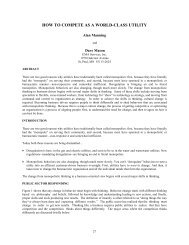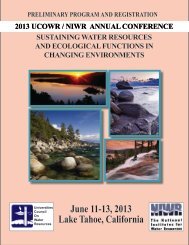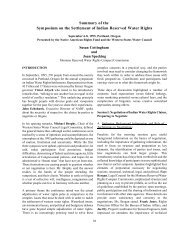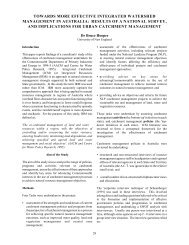Full Journal of Contemporary Water Research and Education, Issue ...
Full Journal of Contemporary Water Research and Education, Issue ...
Full Journal of Contemporary Water Research and Education, Issue ...
Create successful ePaper yourself
Turn your PDF publications into a flip-book with our unique Google optimized e-Paper software.
IWRM Frameworks: USA <strong>and</strong> South Africa77<strong>and</strong> legal/institutional pillars to ensure the longtermsustainability <strong>of</strong> these efforts (Schad 1998,Viessman, Jr. 1998, Ballweber 1999, Galloway2003).In 1998, the President <strong>and</strong> Vice Presidentattempted to provide leadership for watershedmanagement <strong>and</strong> many elements <strong>of</strong> IWRMthrough a Clean <strong>Water</strong> Action Plan (United States<strong>of</strong> America 1998, 2000). The Plan had threegoals: (1) enhance public health protection fromwater pollution threats, (2) more effective control<strong>of</strong> polluted run<strong>of</strong>f, <strong>and</strong> (3) promote water qualityprotection on a watershed basis. Regarding thepolitical pillar, Congress did not have a singleauthorizing or appropriating committee to debatethe entire plan. So despite general support fromimpacted interest groups <strong>and</strong> stakeholders, therewas no opportunity for Congress to conduct acomprehensive review <strong>of</strong> the plan or considerfunding trade<strong>of</strong>fs between agencies <strong>and</strong> similarprograms (Copel<strong>and</strong> 1998, 2000). The Plan waslargely ab<strong>and</strong>oned when a new administration took<strong>of</strong>fice in the Executive Branch.Notwithst<strong>and</strong>ing the lack <strong>of</strong> a national IWRMstrategy, the national government has shownpolitical, legal <strong>and</strong> institutional support for somehigh pr<strong>of</strong>ile, “great waterbody” initiatives withstrong state <strong>and</strong> local political support such as theFlorida Everglades, Great Lakes, <strong>and</strong> ChesapeakeBay (Hughes <strong>and</strong> Burke, Jr. 1996, Ballweber1999, Copel<strong>and</strong> 2000). Reflecting the importance<strong>of</strong> vertical integration in the political <strong>and</strong> legal/institutional pillars, state <strong>and</strong> local politicalsupport on a multi-state or regional scale can sparkfederal political support for legal/institutionalflexibility <strong>and</strong> funding for watershed managementefforts (Hughes et al. 1996). The country’s largelyinformal bottom-up, collaborative approach towatershed management still struggles as individualwatershed partnerships attempt to gain legitimacywith federal <strong>and</strong> state agencies in adoptingmanagement plans, or to wean themselves <strong>of</strong>f<strong>of</strong> agency grant funding (Ballweber et al. 2005,Sabatier et al. 2005). Agencies are quick toparticipate in such collaborative efforts, but are<strong>of</strong>ten legally prohibited from delegating any <strong>of</strong>their authority or responsibilities to these newpartnerships.Near-Term Opportunities for IWRMIn evaluating IWRM, it is vital to rememberthat it is a process <strong>and</strong> not an event (Hooper 2003,MacKay 2003). Despite the fact that South Africahas created a very sound top-down framework tosupport Catchment Management Agencies, it is stillexperiencing challenges in effectively empoweringlocal collaborative initiatives or partnerships(Hattingh et al. 2004, MacKay <strong>and</strong> Ashton 2004,Maharaj <strong>and</strong> Pietersen 2004, Waalewijn et al.2005). A formal national IWRM framework needsto have sufficient flexibility to realize that not allcatchments are equally ready for IWRM, or tocreate <strong>and</strong> participate in a Catchment ManagementAgency. Chess <strong>and</strong> Gibson (2001) identify threefundamental attributes for successful, sustainablewatershed management efforts that are equallyapplicable to IWRM:1. Scientifi c Feasibility – management mustinclude specific actions with a clear causalrelationship between actions taken <strong>and</strong>measurable improvements in meeting prioritywater issues;2. Social Feasibility – agency agendas mustaddress local priorities <strong>and</strong> needs reflectedby strong civic engagement <strong>and</strong> leadership;similarly a statutory framework to delegateauthority, establish planning procedures <strong>and</strong>prioritize technical <strong>and</strong> financial assistanceresources is important; <strong>and</strong>3. Motivational Feasibility – as they evolve,watershed management may need differentapproaches to maintain strong localparticipation including incentives (regulatoryflexibility), norm-based (stakeholders wantto conform to new norms) or other emotionalresponses (civic pride).Much like watershed management, IWRMis more likely to succeed <strong>and</strong> be sustainable incatchments with all three attributes. Agencies<strong>and</strong> other organizations can lay the groundworkfor successful future implementation <strong>of</strong> IWRMplans by working to strengthen individualattributes at the local level as part <strong>of</strong> internationalor national IWRM approaches. By recognizingriver basins where these attributes are alreadyin place, agencies <strong>and</strong> other organizations canhelp prioritize areas for early or fast track IWRMefforts while working to build or strengthen localJOURNAL OF CONTEMPORARY WATER RESEARCH & EDUCATIONUCOWR








